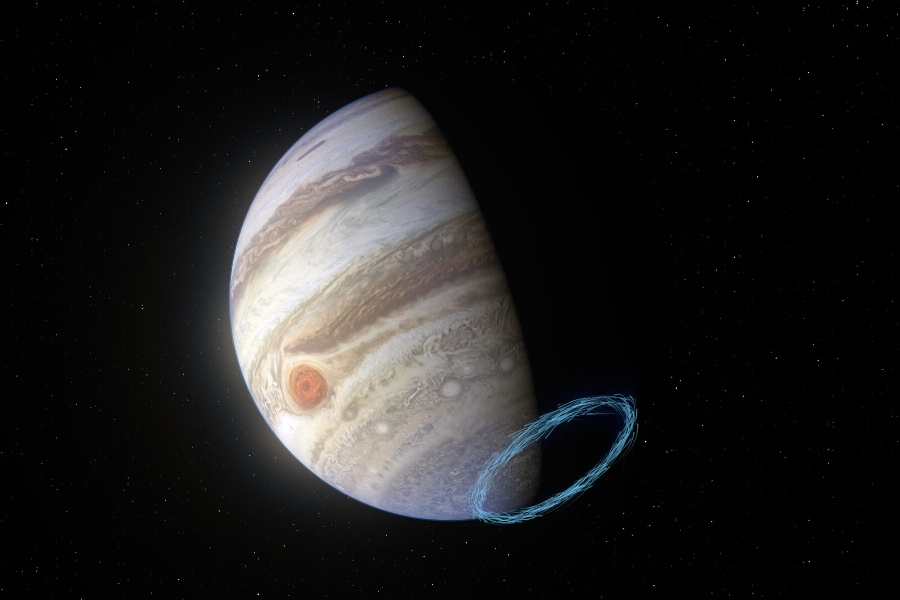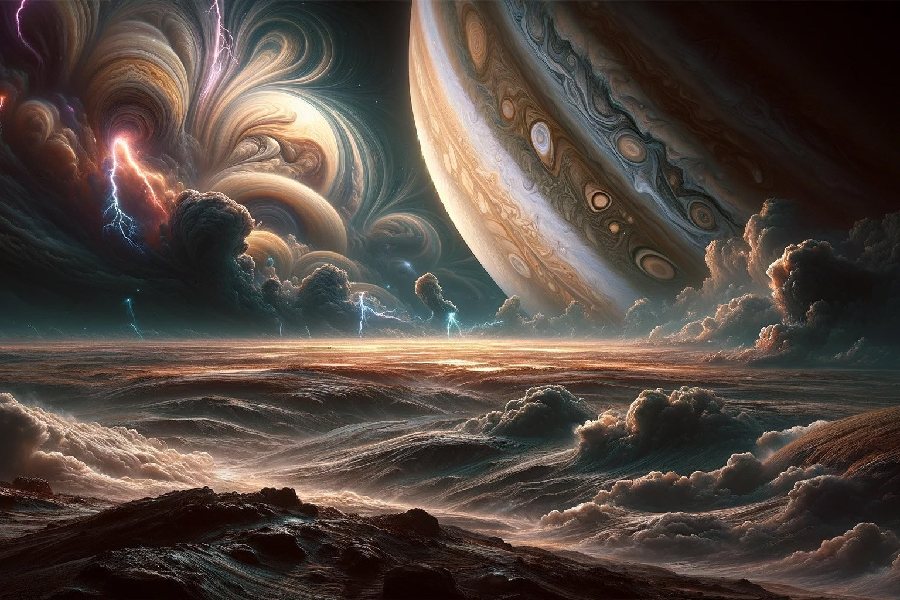As the largest planet in our cosmic neighborhood, Jupiter’s sheer size and awe-inspiring storms have fascinated us for centuries. One intriguing aspect that continues to pique curiosity is the question: Is Jupiter windy?
This article embarks on a captivating exploration of Jupiter’s atmosphere. We’ll dive into the mysteries hidden within its depths, from the dance of cloud formations to the forces behind the planet’s dynamic character.
Prepare to be swept away on a journey of discovery. We’ll decipher the language of cloud patterns, uncover the secrets of swirling storms, and explore the fascinating world beneath Jupiter’s vibrant exterior. Buckle up and join us as we embark on this awe-inspiring adventure.

Is Jupiter Windy?
Yes, Jupiter is extremely windy. Its atmosphere hosts powerful winds, reaching up to 400 miles per hour (about 640 kilometers per hour). These winds play a significant role in shaping Jupiter’s dynamic weather patterns.
They drive massive storms and create swirling cloud formations across the planet. The planet’s fast rotation and vast size contribute to the intensity of its winds, making Jupiter one of the windiest places in the Solar System.
Wind Characteristics and Significance
Jupiter’s atmosphere is a bustling realm of wind activity. Bands of zonal winds tirelessly encircle the planet, akin to nomadic travelers on an endless journey. Among them, swirling vortices like the Great Red Spot add to this mesmerizing dance. These winds are integral to creating the dazzling auroras that grace Jupiter’s skies.
Interestingly, wind speeds across the planet vary significantly. The fastest gusts, exceeding 248 miles per hour (400 kilometers per hour), reside within the equatorial jet streams. Deeper within, winds suspected to reach 1,242 miles per hour (2,000 kilometers per hour) may even break the sound barrier!
But these winds are not passive spectators but the prime movers behind Jupiter’s ever-changing weather patterns and colossal storms. Driven by the planet’s rotation and internal heat, they are crucial in redistributing atmospheric chemicals and shaping our dynamic environment.
Moreover, these swirling vortices disrupt regional weather patterns. They carry heat and gases across vast distances, further contributing to the planet’s complex atmospheric dynamics.
Wind speeds
Jupiter boasts highly diverse winds, with speeds varying greatly by location and depth. While jet streams near the clouds whip at speeds between 62 and 248 miles per hour (100 and 400 kilometers per hour), surpassing hurricane force on Earth, the true power lies below the surface.
Models suggest winds here may reach a staggering 1,242 miles per hour (2,000 kilometers per hour), approaching supersonic speeds. This extreme power, fueled by Jupiter’s internal heat, drives the planet’s dynamic and ever-changing atmosphere.
Polar winds
Jupiter’s polar regions display unique wind patterns that differ from those at other latitudes. At the north and south poles, there are cold circumpolar cyclones spinning. These cyclones are accompanied by auroral processes, which stem from complex interactions within the magnetosphere centered on the poles.
Studying these polar regions provides valuable insights into the rotational dynamics and the external factors influencing Jovian weather systems. Cyclonic storm systems, resembling hurricanes or typhoons on Earth, envelop both poles.
These storms have a central low pressure, potentially connecting with deeper atmospheric convection from much lower depths. However, the exact interactions between these polar vortices and neighboring jet streams remain unclear.
Dazzling auroral displays
Charged particles from the solar wind follow magnetic field lines into Jupiter’s poles. Jupiter boasts dazzling northern and southern lights, similar to Earth’s auroras. These stunning displays are generated by high-energy particles interacting with the planet’s atmosphere.
Yet, unlike Earth, the exact reasons for the variations in auroral brightness and shapes remain a mystery. These variations likely depend on variable polar winds, which interact with the planet’s dynamic magnetosphere through complex electromagnetic relationships currently being unraveled.

Formation of Jupiter’s winds
Why is Jupiter so windy? Various processes work together to produce and sustain the powerful winds in Jupiter’s atmosphere. The planet’s swift rotation kickstarts distinct bands due to the Coriolis effect. These bands interact with convection currents, which carry heat from the planet’s interior to its surface.
As a result of these interactions, noticeable differences in pressure and temperature form, giving rise to enduring east-west jet streams. On a planetary scale, waves emerge, forming vortices and cyclones that can be observed even with telescopes.
The combination of these processes forms a complex dynamic system that changes over time. Observations have revealed long-term alterations in Jupiter’s jet streams and the appearance of its belts and zones. Even the iconic Great Red Spot experiences fluctuations in its size, color, and drift rate spanning decades.
Solar heating
Uneven solar heating plays a secondary role compared to internal heat. But it does create some latitudinal differences driving air mass motions similar to Earth. These contribute smaller north-south circulations which get deflected east-west by Coriolis forces.
This adds turbulence to jet streams centered on the equator. Changes in sunlight absorption may induce climate shifts over centuries due to perturbations in global energy budgets and heat transport.
Solar forcing may also interact with internal convection currents as well on decadal timescales. This could be reflected in the observed variations in Jupiter’s equatorial belt and zone motifs, which have been imaged since the 17th century onward.
Convection currents
Heat leaking from Jupiter’s interior triggers vertical and horizontal convection currents. These currents bring deep gases upward, flowing towards the poles and descending, forming distinct atmospheric bands. This process is powered by Jupiter’s internal heat flow, which surpasses the energy received from sunlight, driving its extreme circulations.
Furthermore, the magnitude of internal heat flow is influenced by factors such as core composition, radiogenic elements, phase changes, and the release of gravitational potential energy. Quantifying this heat transport helps scientists better understand Jupiter’s interior structure and thermal evolution. There are ongoing debates about additional heat sources, including processes like helium rainout and immiscibility.
Jet streams and the Coriolis effect
Laterally alternating convection cells on Jupiter create zones of rising and falling pressures aligned along latitude lines. These zones give rise to powerful eastward and westward jet streams, reaching speeds exceeding 248 miles per hour (400 kilometers per hour) within the cloud tops, much faster than Earth’s.
These jet streams delineate the boundaries between Jupiter’s belts and zones, which are observable through telescopes. By studying the latitudinal distribution of jet streams, scientists gain insights into the deeper thermal structure and dynamics that shape the distinct banded appearance of Jupiter’s clouds.
The wind shear within the jet streams is crucial in maintaining iconic anticyclonic formations like the Great Red Spot by counteracting destructive turbulence along the vortex boundaries. Ongoing changes in the jet streams offer clues to the complex interactions at play, which scientists are still working to decipher.
Moreover, Jupiter’s rapid rotation and convection generate robust zonal flows. When these currents attempt to move poleward or equatorward, the Coriolis effect deflects them perpendicular to the rotation axis, organizing them into coherent latitudinal jet streams rather than chaotic swirling patterns.
The Great Red Spot and Other Storms
The Great Red Spot, a colossal oval vortex, is twice the width of Earth and situated just below Jupiter’s equatorial current. Remarkably, this enduring tempest has persisted for over 150 years since its initial observation.
Over extended periods, the Great Red Spot undergoes length, drift rate, and color tone fluctuations. The formation of such anticyclonic structures relies on vertical wind shear from nearby jet streams, which helps mitigate destructive turbulence along their edges. The distinctive red hues likely result from compounds dredged up from below interacting with solar photons.
Despite its ferocity, convective motions sustain the Great Red Spot’s energy against friction, akin to the stability mechanisms found in terrestrial hurricanes. Jupiter’s turbulent atmosphere is peppered with numerous smaller storms, including white ovals, brown barges, and occasional Little Red Spots. These features emerge and fade over months or years, influenced by perturbations in the planet’s jet streams.
Each storm system contributes to the intricate network of turbulent interaction regions, providing fertile ground for chaos theorists to study the emergence of patterns. Beneath the visible cloud layers, deeper storms linked to internal heating remain shrouded in mystery, awaiting further exploration.
Conclusion
Is Jupiter windy? By piecing together evidence from cloud movements and sophisticated atmospheric modeling, we have arrived at a clear answer: Jupiter is most assuredly a windy world.
From the mesmerizing dance of cloud formations to the enduring tempest of the Great Red Spot, Jupiter’s atmosphere is a realm of constant motion and intrigue. As we unravel the mysteries hidden within its depths, we gain valuable insights into the complex dynamics that govern Jupiter and planetary atmospheres throughout the cosmos.
